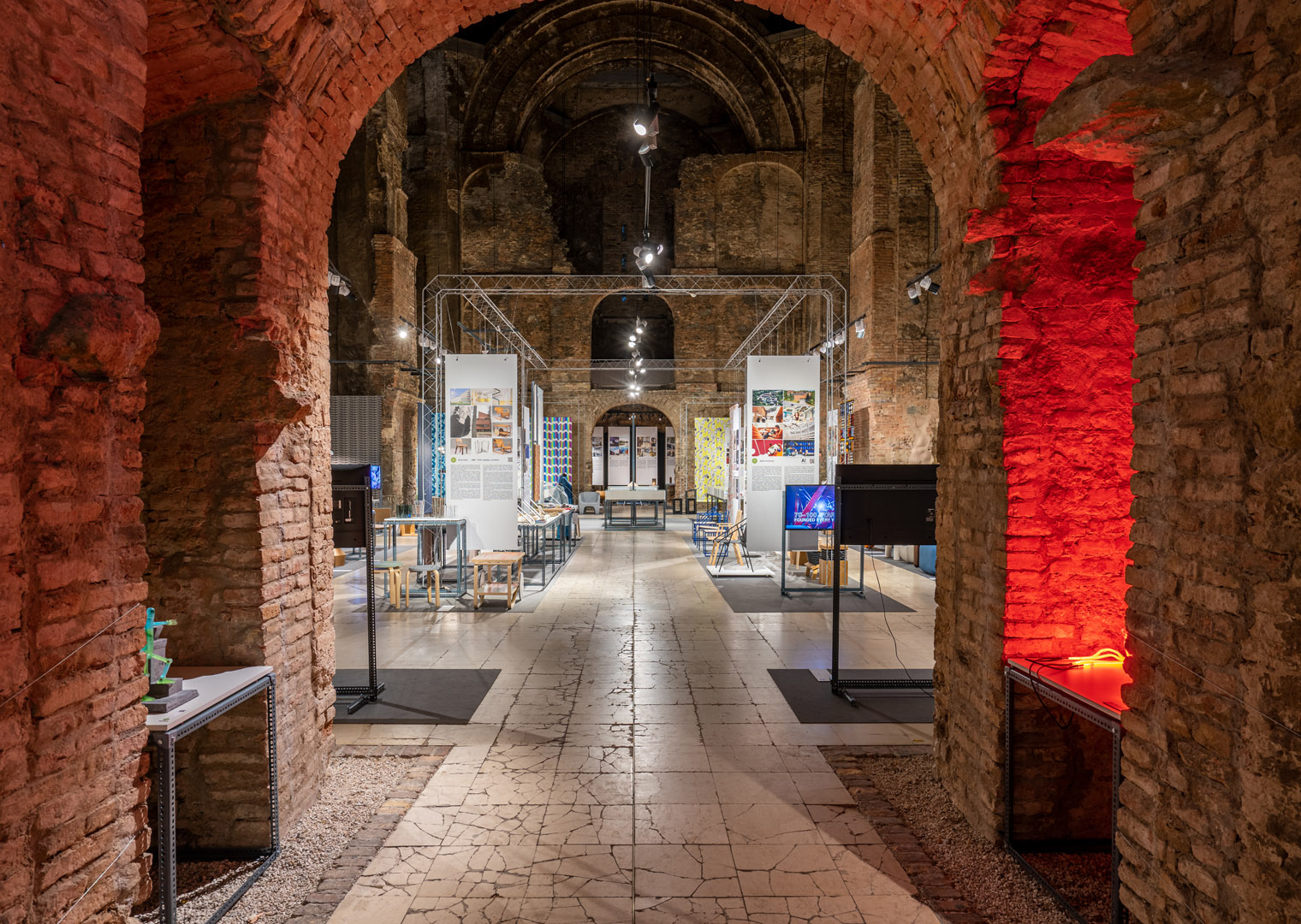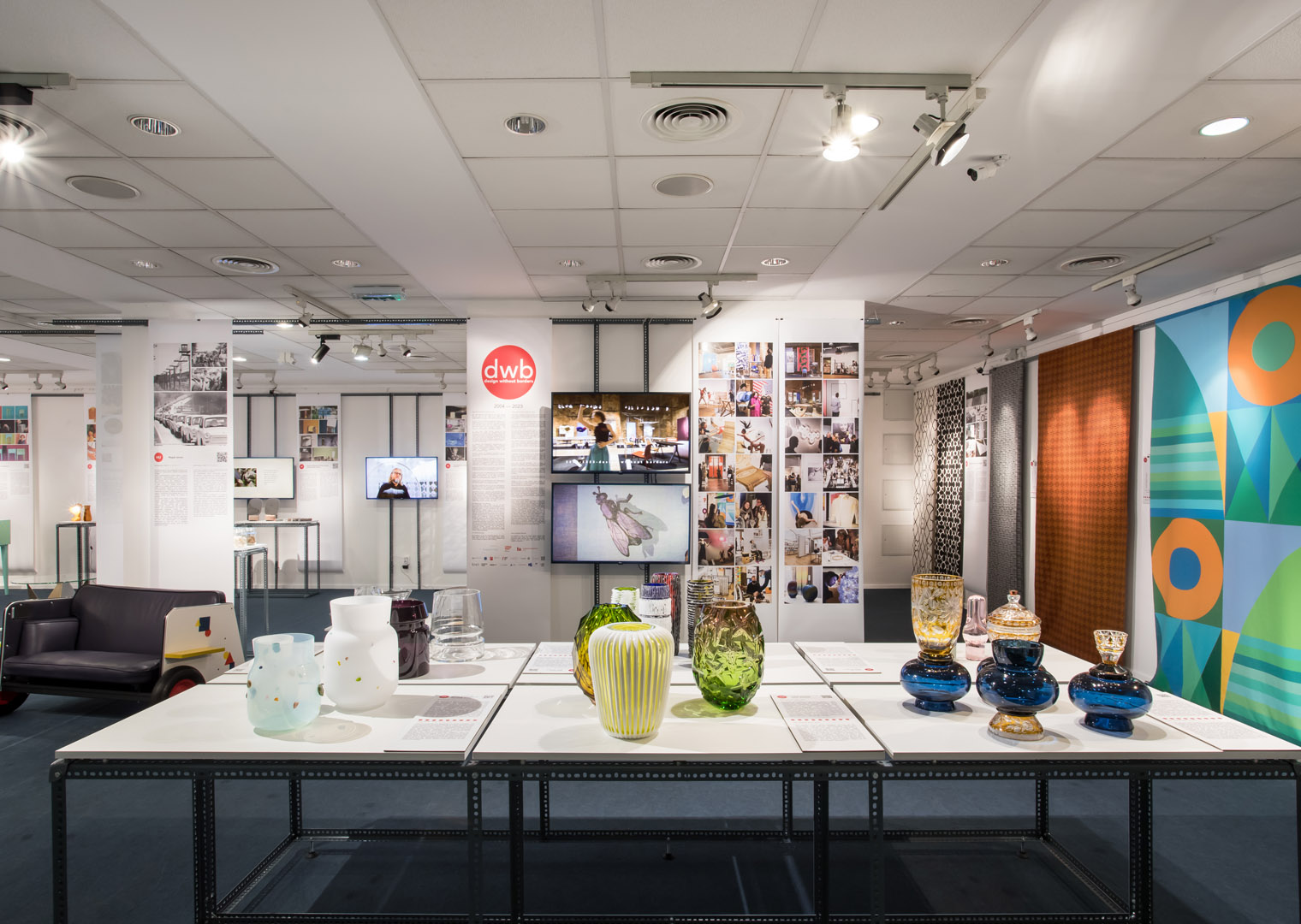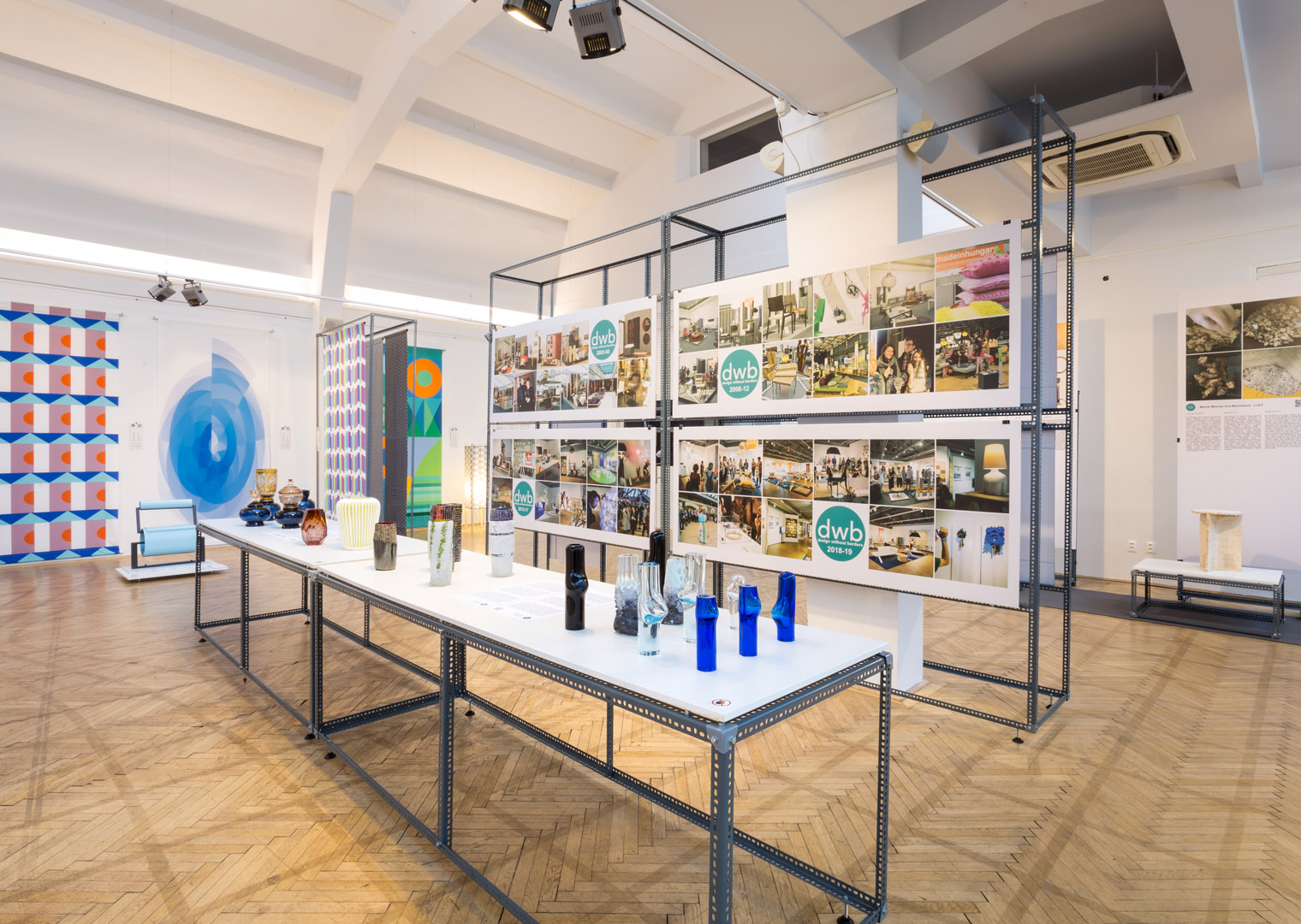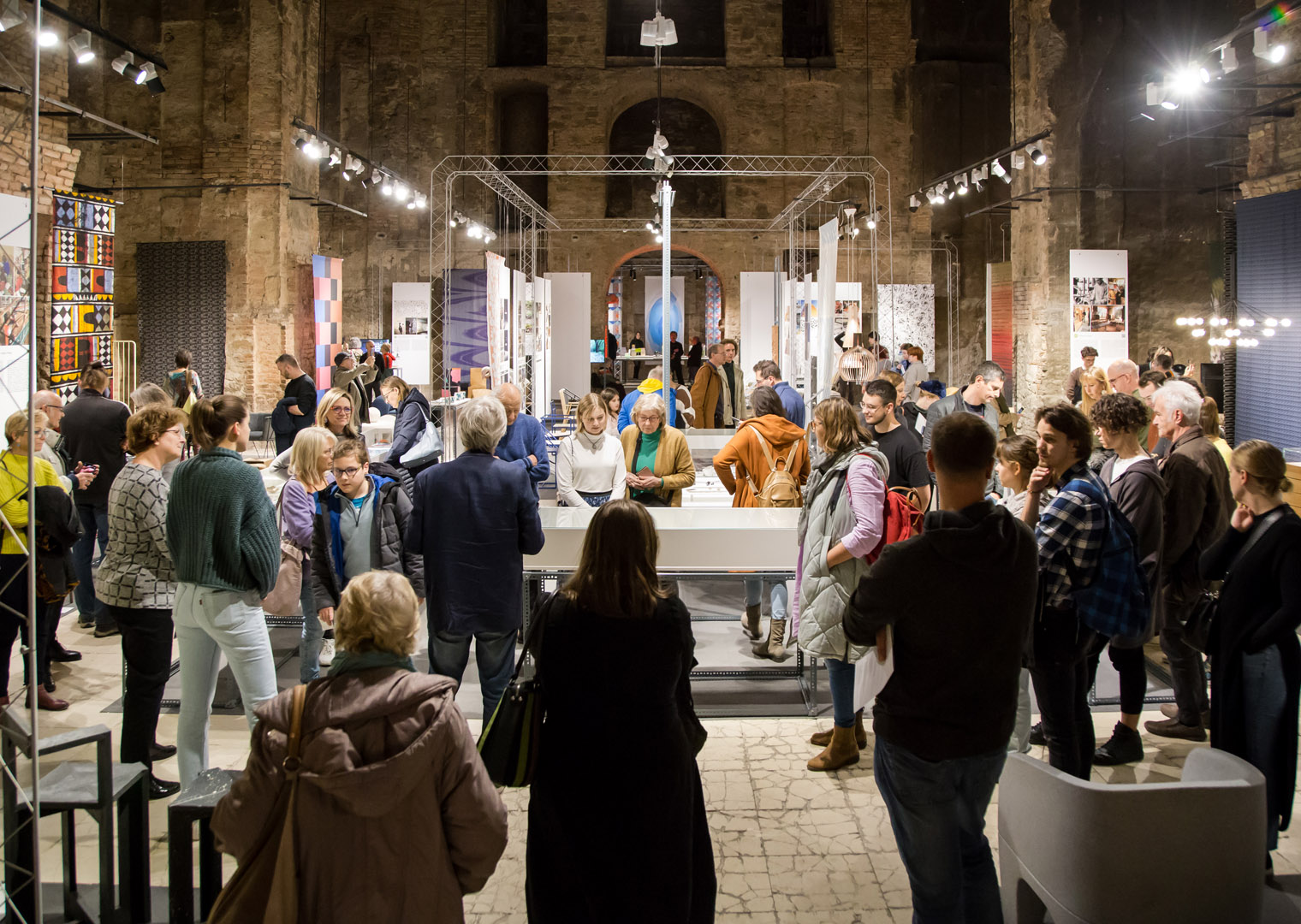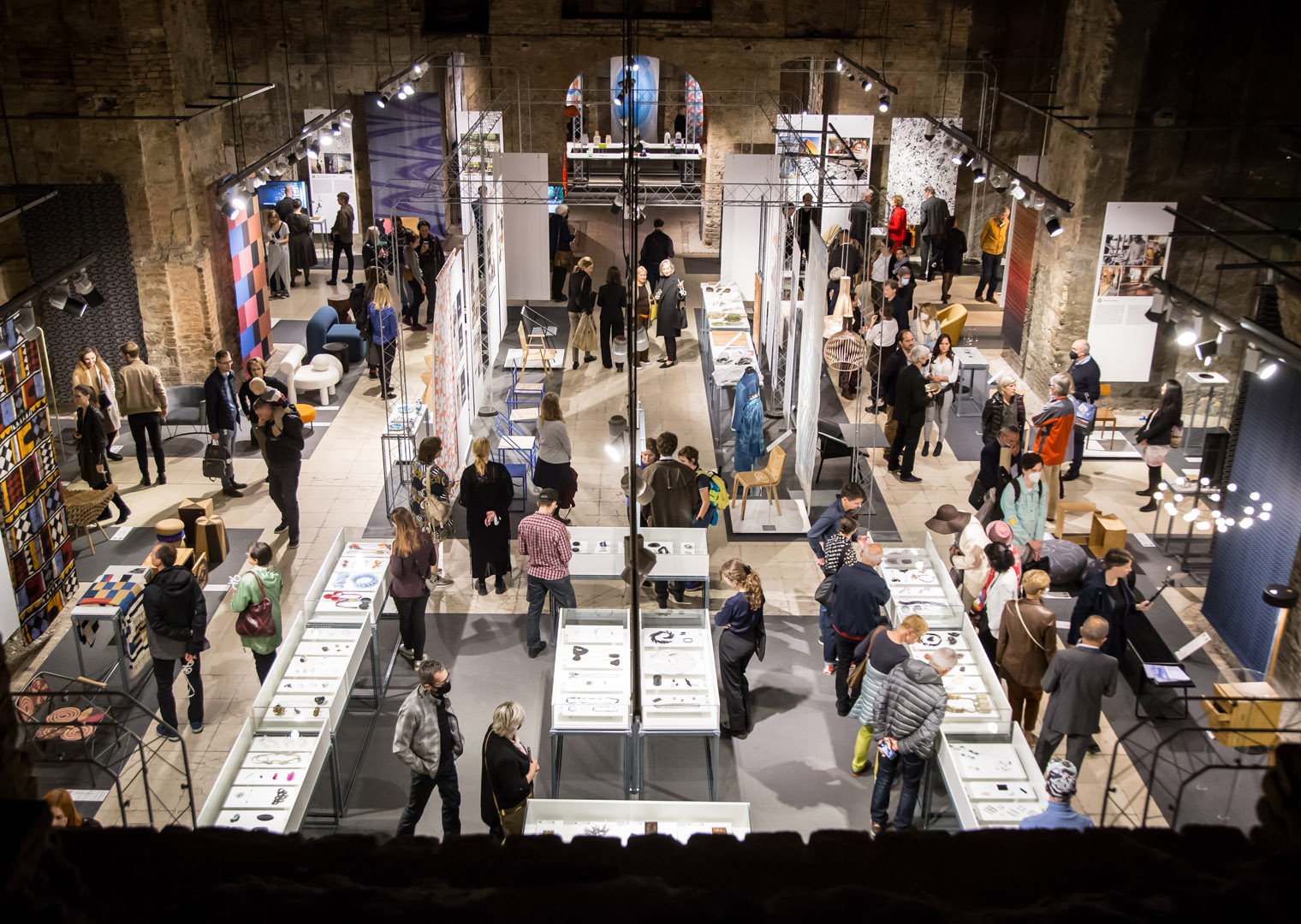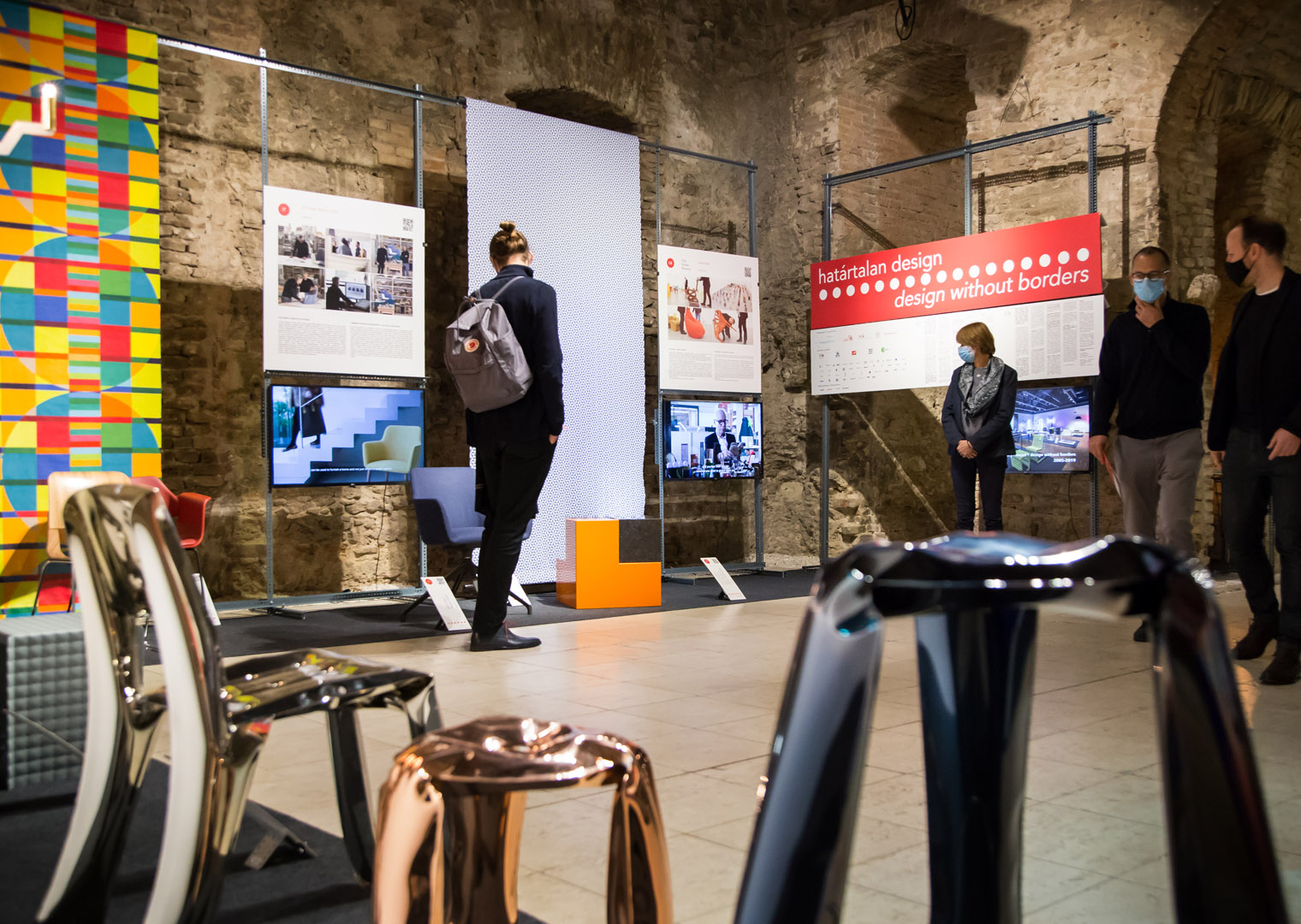Design without borders
Basic information
Project Title
Design without borders
Full project title
Design without borders An international design and all arts exhibition, event series and network
Category
Regaining a sense of belonging
Project Description
The Design Without Borders project is a 20-year old international, independent, non-institutional NGO initiative that is one of the region's most influential design and all-arts events, focusing on European cohesion, interoperability between different regions, artistic disciplines and themes, intergenerational dialogue, sustainability, innovation and networking. Since the outbreak of war in Ukraine, its mission has been to showcase Ukrainian artists too.
Geographical Scope
Cross-border/international
Project Region
CROSS-BORDER/INTERNATIONAL: Austria, Belgium, Czechia, Denmark, Estonia, Finland, France, Germany, Greece, Hungary, Italy, Latvia, Lithuania, Netherlands, Poland, Portugal, Romania, Ukraine, Slovakia, Slovenia, Spain, Sweden, Norway, Svajc, Ukraine, UK
Urban or rural issues
It addresses urban-rural linkages
Physical or other transformations
It refers to other types of transformations (soft investment)
EU Programme or fund
No
Description of the project
Summary
Regaining a sense of belonging - A major commitment at the European level, especially in the increasingly anti-EU political climate of recent years, especially NOW in Hungary and Central Europe.
DWB is an independent grassroots initiative organised annually without institutional backing, based on a network that has been consistently growing over 20 years, personal contacts and experience exchange between different EU countries and regions. The project targets visual and performing artists, including designers, visual artists, musicians, contemporary dance artists, students of art universities, professionals of the creative industry, and journalists and the general public interested in the all-arts scene.
DWB further generates significant projects for a more liveable Europe and common European values along the above-mentioned themes – European cohesion, interoperability between different regions, art disciplines and themes, intergenerational dialogue, sustainability, innovation, eco- and socio-conscious projects.
The educational and experience-sharing impact of in-person and online meetings is huge. We discuss economic and cultural experiences, we solve implementation problems regarding object creation (e.g. if a technology is absent in one region, we help find it in another), we generate significant eco- and socio-conscious projects, we inspire each other, etc.
On average, our exhibitions feature 150-200 visual artists and 20-25 performers from 15-20 countries.
The 21 exhibitions thus far have featured nearly 1,000 designers and visual artists, the accompanying events have featured nearly 800 musicians, contemporary dancers and other performers, and helped create nearly 100 new projects. DWB is an annual event held mainly in Budapest; and in 2023 in Bratislava and Vienna too.
To organise DWB, we apply to grants of the participating countries. We involve cultural institutions from the participating countries as collaborating partners in the implementation.
DWB is an independent grassroots initiative organised annually without institutional backing, based on a network that has been consistently growing over 20 years, personal contacts and experience exchange between different EU countries and regions. The project targets visual and performing artists, including designers, visual artists, musicians, contemporary dance artists, students of art universities, professionals of the creative industry, and journalists and the general public interested in the all-arts scene.
DWB further generates significant projects for a more liveable Europe and common European values along the above-mentioned themes – European cohesion, interoperability between different regions, art disciplines and themes, intergenerational dialogue, sustainability, innovation, eco- and socio-conscious projects.
The educational and experience-sharing impact of in-person and online meetings is huge. We discuss economic and cultural experiences, we solve implementation problems regarding object creation (e.g. if a technology is absent in one region, we help find it in another), we generate significant eco- and socio-conscious projects, we inspire each other, etc.
On average, our exhibitions feature 150-200 visual artists and 20-25 performers from 15-20 countries.
The 21 exhibitions thus far have featured nearly 1,000 designers and visual artists, the accompanying events have featured nearly 800 musicians, contemporary dancers and other performers, and helped create nearly 100 new projects. DWB is an annual event held mainly in Budapest; and in 2023 in Bratislava and Vienna too.
To organise DWB, we apply to grants of the participating countries. We involve cultural institutions from the participating countries as collaborating partners in the implementation.
Key objectives for sustainability
One of DWB's top priorities is sustainability.
30% of the projects presented at the exhibition deal with this. The educational impact of projects presented during guided tours and face-to-face and online meetings is invaluable, providing a major inspiration for exhibitors and visitors alike.
Some concrete highlight examples for eco-conscious projects that were showcased include: in 2020, the Design Academy Eindhoven Graduate Show's major projects on sustainable development; in 2021, the Biennial of Design (BIO), Ljubljana's important projects in the context of the Slovenian focus and Noemi Niederhauser’s Wastematter "Innovative material centered around the revaluation of drafts of beer from the city of Lausanne (CH)" project; and in 2022, the "Design for a Cooler Planet" and "Better to Wear and Infinite Materials" projects of Helsinki’s Alvar Aalto University.
I will also highlight some important socially conscious projects in the field of sustainability.
In 2020, we presented the Romanian Delta Craft project, which showcased the creation of design products based on the craft traditions found in the Danube Delta. In 2022, Slovak designer Zuzana Zmatekova’s project Amenge was showcased, which is a collection of prints designed in collaboration with Slovakian Romani kids, aiming to present Romani culture outside of the common ethnic stereotypes.
Another project for sustainability is the DWB TEXHIBITION, which brings together textile designers and manufacturers every year in conjunction with DWB. The results of these collaborations go on display at the DWB exhibition.
All in all, the DWB project is an important example of sustainable development in itself, as we have managed to sustain and grow the DWB network as an independent project – which is a particular achievement in Hungary today – for the past 20 years.
30% of the projects presented at the exhibition deal with this. The educational impact of projects presented during guided tours and face-to-face and online meetings is invaluable, providing a major inspiration for exhibitors and visitors alike.
Some concrete highlight examples for eco-conscious projects that were showcased include: in 2020, the Design Academy Eindhoven Graduate Show's major projects on sustainable development; in 2021, the Biennial of Design (BIO), Ljubljana's important projects in the context of the Slovenian focus and Noemi Niederhauser’s Wastematter "Innovative material centered around the revaluation of drafts of beer from the city of Lausanne (CH)" project; and in 2022, the "Design for a Cooler Planet" and "Better to Wear and Infinite Materials" projects of Helsinki’s Alvar Aalto University.
I will also highlight some important socially conscious projects in the field of sustainability.
In 2020, we presented the Romanian Delta Craft project, which showcased the creation of design products based on the craft traditions found in the Danube Delta. In 2022, Slovak designer Zuzana Zmatekova’s project Amenge was showcased, which is a collection of prints designed in collaboration with Slovakian Romani kids, aiming to present Romani culture outside of the common ethnic stereotypes.
Another project for sustainability is the DWB TEXHIBITION, which brings together textile designers and manufacturers every year in conjunction with DWB. The results of these collaborations go on display at the DWB exhibition.
All in all, the DWB project is an important example of sustainable development in itself, as we have managed to sustain and grow the DWB network as an independent project – which is a particular achievement in Hungary today – for the past 20 years.
Key objectives for aesthetics and quality
DWB aims to create high-level exhibitions and event series based on the themes already listed above – European cohesion, interoperability between different regions, artistic disciplines and themes, intergenerational dialogue, sustainability, innovation, eco- and socio-conscious projects. However, unlike the horrid, pretentious 'business-oriented' trade exhibitions, it intends to focus on the environment, on design products, and on the innovative thinking and the creative artist, while keeping in mind minimalism, recycling and sustainability in the aesthetics of the exhibition.
Educational films and videos make the exhibition content even more eye-catching.
Paper-based catalogues are not produced at all, with environmental considerations in mind.
Our website provides an excellent summary. It is transparent, of a high aesthetic quality, with important aesthetic content relevant to creative industry professionals, artists and researchers of the subject.
Overall, the DWB project has an aesthetic impact that reaches a wide audience and is aesthetically significant.
Educational films and videos make the exhibition content even more eye-catching.
Paper-based catalogues are not produced at all, with environmental considerations in mind.
Our website provides an excellent summary. It is transparent, of a high aesthetic quality, with important aesthetic content relevant to creative industry professionals, artists and researchers of the subject.
Overall, the DWB project has an aesthetic impact that reaches a wide audience and is aesthetically significant.
Key objectives for inclusion
DWB is very open in terms of inclusion, our aim is to make it as accessible and affordable as possible.
The DWB project’s 20-year history is obviously rooted in the commitment of its organisers.
The project is run by Unikát Bt., established in 1994 by interior designer Tamás Radnóti and textile designer Szilvia Szigeti, They have created an exemplary network.
As mentioned above, the thus far 21 exhibitions have featured nearly 1,000 designers and visual artists, the accompanying events included nearly 800 musicians, contemporary dancers and performers, nearly 100 new projects have been created. The website provides access to nearly 1,000 artists, virtual tours, photo albums, 154 short films (DWB – VLOG) and blogs.
The exhibition and the events – at the Kiscelli Museum in Budapest, at the Umelka Gallery in Bratislava and at the Collegium Hungaricum in Vienna – are visitable with a normal museum ticket / free of charge.
The reason for this is that the project is non-profit, we apply to the tenders of the cultural funds of the participating countries (e.g. Hungarian Nat. Cultural Fund (HU), Mickiewicz Inst. (PL), Austrian Cultural Forum (AT), Internat. Visegrad Fund (V4)).The cultural institutes and EUNIC clusters of the participating countries were / are involved in the implementation of the exhibition in Budapest, Bratislava and Vienna (e.g. with transport, PR activities, modest financial support, contacts).
Exhibitors do not pay a fee, which is a big relief as the creative field itself is very capital-intensive.
We also try to involve other sponsors along the lines of social engagement.
We have created the DWB Award, sponsored by NGOs, entrepreneurs or other companies; we thus manage to support 4 young artists every year.
Additionally, we bring together designers with manufacturers, mainly in the field of textile design.
We can be justifiably proud of having created and maintained the DWB platform for 20 years and making it accessible to a wide audience.
The DWB project’s 20-year history is obviously rooted in the commitment of its organisers.
The project is run by Unikát Bt., established in 1994 by interior designer Tamás Radnóti and textile designer Szilvia Szigeti, They have created an exemplary network.
As mentioned above, the thus far 21 exhibitions have featured nearly 1,000 designers and visual artists, the accompanying events included nearly 800 musicians, contemporary dancers and performers, nearly 100 new projects have been created. The website provides access to nearly 1,000 artists, virtual tours, photo albums, 154 short films (DWB – VLOG) and blogs.
The exhibition and the events – at the Kiscelli Museum in Budapest, at the Umelka Gallery in Bratislava and at the Collegium Hungaricum in Vienna – are visitable with a normal museum ticket / free of charge.
The reason for this is that the project is non-profit, we apply to the tenders of the cultural funds of the participating countries (e.g. Hungarian Nat. Cultural Fund (HU), Mickiewicz Inst. (PL), Austrian Cultural Forum (AT), Internat. Visegrad Fund (V4)).The cultural institutes and EUNIC clusters of the participating countries were / are involved in the implementation of the exhibition in Budapest, Bratislava and Vienna (e.g. with transport, PR activities, modest financial support, contacts).
Exhibitors do not pay a fee, which is a big relief as the creative field itself is very capital-intensive.
We also try to involve other sponsors along the lines of social engagement.
We have created the DWB Award, sponsored by NGOs, entrepreneurs or other companies; we thus manage to support 4 young artists every year.
Additionally, we bring together designers with manufacturers, mainly in the field of textile design.
We can be justifiably proud of having created and maintained the DWB platform for 20 years and making it accessible to a wide audience.
Results in relation to category
In many ways, the DWB network and the projects it has generated meet, and even comprehensively represent at the European level, the criteria described in the "Regaining a sense of belonging" category.
The thematic units of the annual, 20-year-old, grassroots international independent design and all-arts exhibition and event series present projects that correspond to the themes listed in the category. The in-person and online meetings linked to the exhibition provide participants and visitors alike with personal presentations by creators from different countries and regions, conveying experience and knowledge, generating joint projects and representing the restoration of a sense of belonging at the European level. DWB is playing an important role especially now, when EU-scepticism is on the rise – especially in Hungary and the region.
We can be justifiably proud that DWB is one of the region's most significant design and all-arts initiatives. Over the 20 years we have organised 21 exhibitions and event series, and presented nearly 1000 artists from 29 countries, organised meetings for them, thus creating a significant network of personal contacts. On average, 150-200 artists from 15-20 countries take part in the annual exhibitions and event series, not only from the region but also from different countries in Europe. The events attract between 4500 and 5500 visitors, with nearly 55000 visitors to our website each year. DWB has generated nearly 100 small and large-scale projects that fit the description of the "Regaining a sense of belonging" category.
As mentioned earlier, as DWB is an independent NGO initiative, it does not receive the recognition and support in Hungary that its importance and status deserves. The New European Bauhaus Award would be particularly important for the continuation of our work, as it would confirm the legitimacy of the DWB project as a symbol of European belonging.
The thematic units of the annual, 20-year-old, grassroots international independent design and all-arts exhibition and event series present projects that correspond to the themes listed in the category. The in-person and online meetings linked to the exhibition provide participants and visitors alike with personal presentations by creators from different countries and regions, conveying experience and knowledge, generating joint projects and representing the restoration of a sense of belonging at the European level. DWB is playing an important role especially now, when EU-scepticism is on the rise – especially in Hungary and the region.
We can be justifiably proud that DWB is one of the region's most significant design and all-arts initiatives. Over the 20 years we have organised 21 exhibitions and event series, and presented nearly 1000 artists from 29 countries, organised meetings for them, thus creating a significant network of personal contacts. On average, 150-200 artists from 15-20 countries take part in the annual exhibitions and event series, not only from the region but also from different countries in Europe. The events attract between 4500 and 5500 visitors, with nearly 55000 visitors to our website each year. DWB has generated nearly 100 small and large-scale projects that fit the description of the "Regaining a sense of belonging" category.
As mentioned earlier, as DWB is an independent NGO initiative, it does not receive the recognition and support in Hungary that its importance and status deserves. The New European Bauhaus Award would be particularly important for the continuation of our work, as it would confirm the legitimacy of the DWB project as a symbol of European belonging.
How Citizens benefit
The DWB project includes visual artists – designers, visual artists, creative teams – and performing artists – musicians, contemporary dancers – as well as photographers, videographers, cinematographers, editors, documenting the project. Exhibitors do not pay a fee.
They will participate in in-person / online meetings, give a 10 minute presentation of their work, promote DWB on their own websites, social media platforms, thus making the project widely available in different countries. Performers apply for concerts and performances and also promote the event.
In-person / online meetings generate subsequent collaborative projects.
Since DWB is a network, 50% of our exhibitors and participants are returning, among whom personal professional and friendly relationships have already been established. This means that we can, for example, often solve implementation problems across national borders and involve each other in various other projects.
As DWB is already a major brand, civil society and citizens are looking forward to the next event series. It is very important that there is now interest in the exhibition and the event series not only from the region but also from different countries in Europe. Each exhibition generates 4500-5500 visitors, with nearly 55000 visitors visiting our website every year.
Almost 100 new small and large-scale projects have already been generated through DWB. A very significant change has been the fact that besides Budapest we also organised exhibitions in Bratislava and Vienna.
As we always try to join larger umbrella events (Budapest Design Week, Vienna Design Week), we have a wide range of participants.
They will participate in in-person / online meetings, give a 10 minute presentation of their work, promote DWB on their own websites, social media platforms, thus making the project widely available in different countries. Performers apply for concerts and performances and also promote the event.
In-person / online meetings generate subsequent collaborative projects.
Since DWB is a network, 50% of our exhibitors and participants are returning, among whom personal professional and friendly relationships have already been established. This means that we can, for example, often solve implementation problems across national borders and involve each other in various other projects.
As DWB is already a major brand, civil society and citizens are looking forward to the next event series. It is very important that there is now interest in the exhibition and the event series not only from the region but also from different countries in Europe. Each exhibition generates 4500-5500 visitors, with nearly 55000 visitors visiting our website every year.
Almost 100 new small and large-scale projects have already been generated through DWB. A very significant change has been the fact that besides Budapest we also organised exhibitions in Bratislava and Vienna.
As we always try to join larger umbrella events (Budapest Design Week, Vienna Design Week), we have a wide range of participants.
Physical or other transformations
It refers to other types of transformations (soft investment)
Innovative character
Innovation plays a key role in DWB. The project is an independent civil network of innovative and responsible artists, professional organisations and universities, working according to European values, European solidarity, the "think globally, act locally" idea, recognising the positive impact of creative interplay between different art disciplines, intergenerational dialogue and openness towards sustainable development, eco- and socio-conscious thinking. The project’s impact on education, the economy and the creative industry is very significant.
Some concrete examples: Different genres usually attract different audiences. Audiences interested in classical music do not necessarily seek the above aspects and do not visit exhibitions with innovative content; whereas audiences of innovation, design and visual arts do not necessarily attend concerts or music-themed exhibitions. It is for this reason that we organised "DWB – Reflections" in October 2023 at the FUGA Budapest Center of Architecture. The exhibition presents sound objects to mark the 100th anniversary of composer György Ligeti’s birth, featuring 54 artists from 14 countries. Besides specific classical music programmes and references, sound objects created at various levels, works of fine art, pieces on the border between science and art, mass-produced products for educational purposes and instrument developments are exhibited too.
Another: The Budapest exhibition in October 2020 would have been followed by exhibitions in Bratislava and Vienna in 2021; but these had to be cancelled due to the pandemic.
However, the organisers made this wealth of material available for everyone – quite literally without borders. Innovative even internationally, a platform called the DWB VLOG was created, containing 30-35 second short films of the exhibited works of the 154 artists from 14 countries. The international premiere of the DWB VLOG took place on the online interface of Dezeen architecture and design magazine.
Some concrete examples: Different genres usually attract different audiences. Audiences interested in classical music do not necessarily seek the above aspects and do not visit exhibitions with innovative content; whereas audiences of innovation, design and visual arts do not necessarily attend concerts or music-themed exhibitions. It is for this reason that we organised "DWB – Reflections" in October 2023 at the FUGA Budapest Center of Architecture. The exhibition presents sound objects to mark the 100th anniversary of composer György Ligeti’s birth, featuring 54 artists from 14 countries. Besides specific classical music programmes and references, sound objects created at various levels, works of fine art, pieces on the border between science and art, mass-produced products for educational purposes and instrument developments are exhibited too.
Another: The Budapest exhibition in October 2020 would have been followed by exhibitions in Bratislava and Vienna in 2021; but these had to be cancelled due to the pandemic.
However, the organisers made this wealth of material available for everyone – quite literally without borders. Innovative even internationally, a platform called the DWB VLOG was created, containing 30-35 second short films of the exhibited works of the 154 artists from 14 countries. The international premiere of the DWB VLOG took place on the online interface of Dezeen architecture and design magazine.
Disciplines/knowledge reflected
The planning and implementation of DWB draws on several disciplines and artistic fields.
In Central Europe, due to historical traditions, social engagement and civic initiative are significantly poorer than in Western Europe. Paternalistic thinking and centralised structures are not conducive to self-organisation.
Recognising this shortcoming, the organisers launched the process by drawing on studies of previous professional and other international economic examples.
Both graduated from the MOME – Moholy-Nagy University of Art and Design, were fellows of the Akademie Schloss Solitude Stuttgart, are active designers with significant international experience, and established their own company and gallery in 1994. They have organised hundreds of exhibitions to date and launched DWB in 2004. The international professional network has been constantly expanding with designers, artists, musicians, international professional organisations and universities. The organisation and realisation of DWB, the selection of projects and exhibitors, the planning of future projects, all involved the cooperation of various professional organisations, universities, galleries, studios, business professionals, having resulted in the creation of an active network. For example, the DWB – Selection exhibition, organised in September 2023 as an official part of the Vienna Design Week, was opened by Dr Reinhard Backhausen, an internationally renowned textile expert, and was attended by representatives of several major professional organisations, ambassadors, heads of cultural institutions and, of course, the exhibitors. British journalist and curator XY also visited the exhibition and the next DWB exhibition was discussed. Through personal contacts, the Vienna exhibition also led to plans for several projects for the coming year.
This ‘snowball’ has been rolling since DWB's inception, opening up new doors for the network's participants. For us, this is the most significant added value.
In Central Europe, due to historical traditions, social engagement and civic initiative are significantly poorer than in Western Europe. Paternalistic thinking and centralised structures are not conducive to self-organisation.
Recognising this shortcoming, the organisers launched the process by drawing on studies of previous professional and other international economic examples.
Both graduated from the MOME – Moholy-Nagy University of Art and Design, were fellows of the Akademie Schloss Solitude Stuttgart, are active designers with significant international experience, and established their own company and gallery in 1994. They have organised hundreds of exhibitions to date and launched DWB in 2004. The international professional network has been constantly expanding with designers, artists, musicians, international professional organisations and universities. The organisation and realisation of DWB, the selection of projects and exhibitors, the planning of future projects, all involved the cooperation of various professional organisations, universities, galleries, studios, business professionals, having resulted in the creation of an active network. For example, the DWB – Selection exhibition, organised in September 2023 as an official part of the Vienna Design Week, was opened by Dr Reinhard Backhausen, an internationally renowned textile expert, and was attended by representatives of several major professional organisations, ambassadors, heads of cultural institutions and, of course, the exhibitors. British journalist and curator XY also visited the exhibition and the next DWB exhibition was discussed. Through personal contacts, the Vienna exhibition also led to plans for several projects for the coming year.
This ‘snowball’ has been rolling since DWB's inception, opening up new doors for the network's participants. For us, this is the most significant added value.
Methodology used
DWB is an independent grassroots initiative based on the commitment of its organisers and participants. Maintaining our independence in this situation is hard. That is why it is crucial to build a network. However, the experience and consistent work of 20 years is slowly but surely starting to pay off. Hence, getting EU support and recognition are key.
Due to historical traditions, the gap in potential and thinking is huge between Eastern and Western Europe. DWB's task is to bridge these gaps, to promote communication between different countries and regions, to build on personal acquaintances and friendships, to understand, accept and help each other, and to implement the resulting concrete projects.
As mentioned above, networking is the most important element of our project. We have managed to attract universities, professional organisations besides the artists. From our network’s point of view, the cultural institutions of the participating countries are pivotal, who are constantly supporting our work. Cultural grants in different countries are important; we apply to these regularly. We have very good relations with umbrella events such as the Budapest Design Week and the Vienna Design Week. We are currently in discussion with the organisers of Cultural Summer Bratislava for next summer’s DWB exhibition, which will give us more publicity. But it is important to do press conferences and have media sponsors.
It is also important to include different artistic disciplines, the all-arts character of the programmes, professional meetings, online conferences, guided tours, which target the general public and professionals from the economic and creative industries.
Due to historical traditions, the gap in potential and thinking is huge between Eastern and Western Europe. DWB's task is to bridge these gaps, to promote communication between different countries and regions, to build on personal acquaintances and friendships, to understand, accept and help each other, and to implement the resulting concrete projects.
As mentioned above, networking is the most important element of our project. We have managed to attract universities, professional organisations besides the artists. From our network’s point of view, the cultural institutions of the participating countries are pivotal, who are constantly supporting our work. Cultural grants in different countries are important; we apply to these regularly. We have very good relations with umbrella events such as the Budapest Design Week and the Vienna Design Week. We are currently in discussion with the organisers of Cultural Summer Bratislava for next summer’s DWB exhibition, which will give us more publicity. But it is important to do press conferences and have media sponsors.
It is also important to include different artistic disciplines, the all-arts character of the programmes, professional meetings, online conferences, guided tours, which target the general public and professionals from the economic and creative industries.
How stakeholders are engaged
As already mentioned several times, DWB is a twenty-year-old international, independent, non-institutional, NGO design and all-arts project and network, which is constantly expanding.
On average, between 4500 and 5500 visitors from within and outside the region visit the event series.
To set up the project, we are applying for grants from the participating countries' cultural funds and the International Visegrad Fund. The cultural institutes of the participating countries and the EUNIC clusters in Budapest, Bratislava and Vienna are also involved in the cooperation. Our very important partners are the cultural institutes, who help with the transport of objects, the promotion of events and modest financial support. Art universities are also regularly involved (e.g. ...), helping with the selection of exhibiting students, contacts and promotion. Major professional organisations have also joined us (e.g. Łódź). Venues for exhibitions, e.g. Kiscelli Museum, Budapest, Collegium Hungaricum, Vienna, provide the venue and the whole infrastructure free of charge. Larger umbrella events are also our partners e.g. BDW and VDW, which promote the event. Our media partners (e.g. Octogon design and architecture magazine, Papageno cultural programme magazine) promote the exhibition in a barter arrangement. The companies involved in our textile project TEXHIBITION offer significant discounts and include our designs in their collections. The DWB Award is supported by NGOs, entrepreneurs and other companies. The logos of our sponsors and partners are linked on our website, their logos are displayed on our indoor and outdoor banners.
Thanks to our consistent work, DWB has become an excellent network.
On average, between 4500 and 5500 visitors from within and outside the region visit the event series.
To set up the project, we are applying for grants from the participating countries' cultural funds and the International Visegrad Fund. The cultural institutes of the participating countries and the EUNIC clusters in Budapest, Bratislava and Vienna are also involved in the cooperation. Our very important partners are the cultural institutes, who help with the transport of objects, the promotion of events and modest financial support. Art universities are also regularly involved (e.g. ...), helping with the selection of exhibiting students, contacts and promotion. Major professional organisations have also joined us (e.g. Łódź). Venues for exhibitions, e.g. Kiscelli Museum, Budapest, Collegium Hungaricum, Vienna, provide the venue and the whole infrastructure free of charge. Larger umbrella events are also our partners e.g. BDW and VDW, which promote the event. Our media partners (e.g. Octogon design and architecture magazine, Papageno cultural programme magazine) promote the exhibition in a barter arrangement. The companies involved in our textile project TEXHIBITION offer significant discounts and include our designs in their collections. The DWB Award is supported by NGOs, entrepreneurs and other companies. The logos of our sponsors and partners are linked on our website, their logos are displayed on our indoor and outdoor banners.
Thanks to our consistent work, DWB has become an excellent network.
Global challenges
As mentioned above, DWB is a so-called independent grassroots NGO initiative based on the commitment of its organisers and participants. Besides today's purely profit-oriented values, it is very important to return to the human values of community belonging, and of connecting different communities, regions and countries. These are based on the development and continuous operation of personal networks.
It is particularly important to reconcile the cultural differences between Eastern and Western Europe and to bring values closer together. I have also referred above to Eastern Europe’s historically paternalistic tradition, which poses a major challenge to independent civil initiatives in our region, and particularly in Hungary. DWB's ambition is to keep the 20-year project going and to build on personal contacts to generate new sustainable, innovative and forward-looking projects for the European community, to connect local initiatives and to give them greater visibility.
It is particularly important to reconcile the cultural differences between Eastern and Western Europe and to bring values closer together. I have also referred above to Eastern Europe’s historically paternalistic tradition, which poses a major challenge to independent civil initiatives in our region, and particularly in Hungary. DWB's ambition is to keep the 20-year project going and to build on personal contacts to generate new sustainable, innovative and forward-looking projects for the European community, to connect local initiatives and to give them greater visibility.
Learning transferred to other parties
DWB's 20-year history has proven that the project can be continuously adapted and expanded.
The change of venue in 2023 is a serious lesson learned. After Budapest, DWB was held abroad for the first time, in Bratislava and Vienna.
The project worked very well in both venues. For example, guided tours are not the norm in Bratislava, but were nevertheless very positively received and even considered as a major added value. The project plan for 2024 was further developed during the professional workshops, and thanks to this, the jubilee event in spring 2024 will have a Slovak and Austrian focus, which will not only allow for exhibitor participation, but also for the formulation of joint project plans in the future.
In particular, we are expanding our TEXHIBITION project (created due to the regrettable decline of the textile industry in Hungary, bringing together manufacturers and designers – as described above) to include Slovak and Austrian participation on the manufacturing side.
The Vienna exhibition was also a great experience. It was special because DWB was the official platform event of the Vienna Design Week, so it was given a special role (all thanks to the Bratislava exhibition in spring). As the international embeddedness of the Vienna Design Week is very significant, DWB was seen by a much wider international audience in Vienna. We can be justifiably proud of the fact that DWB was mentioned by the public and the professional press as one of the most important exhibitions and projects of the Vienna Design Week.
It has opened new doors for our exhibitors, as it has generated several international enquiries (e.g. 100% Design London, Schmuckmuseum Pforzheim), which could be significant opportunities for the future.
The change of venue in 2023 is a serious lesson learned. After Budapest, DWB was held abroad for the first time, in Bratislava and Vienna.
The project worked very well in both venues. For example, guided tours are not the norm in Bratislava, but were nevertheless very positively received and even considered as a major added value. The project plan for 2024 was further developed during the professional workshops, and thanks to this, the jubilee event in spring 2024 will have a Slovak and Austrian focus, which will not only allow for exhibitor participation, but also for the formulation of joint project plans in the future.
In particular, we are expanding our TEXHIBITION project (created due to the regrettable decline of the textile industry in Hungary, bringing together manufacturers and designers – as described above) to include Slovak and Austrian participation on the manufacturing side.
The Vienna exhibition was also a great experience. It was special because DWB was the official platform event of the Vienna Design Week, so it was given a special role (all thanks to the Bratislava exhibition in spring). As the international embeddedness of the Vienna Design Week is very significant, DWB was seen by a much wider international audience in Vienna. We can be justifiably proud of the fact that DWB was mentioned by the public and the professional press as one of the most important exhibitions and projects of the Vienna Design Week.
It has opened new doors for our exhibitors, as it has generated several international enquiries (e.g. 100% Design London, Schmuckmuseum Pforzheim), which could be significant opportunities for the future.
Keywords
Focusing on European cohesion
Interoperability between artistic disciplines and themes
Intergenerational dialogue
Sustainability and innovation
Networking

